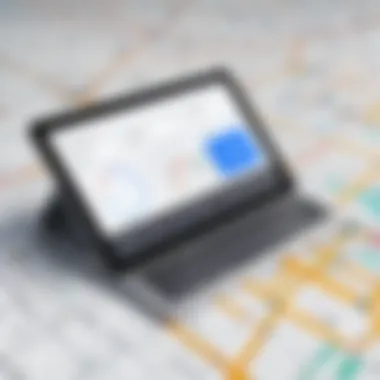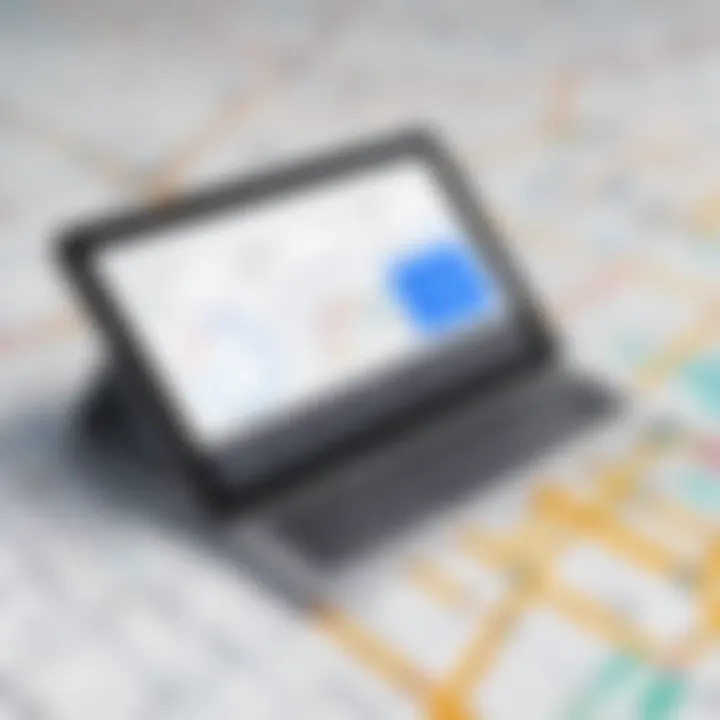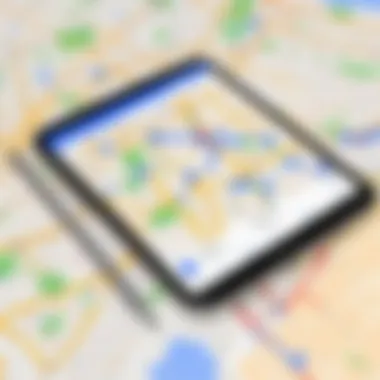Measure Areas Efficiently with Google Maps Calculator


Intro
In today’s fast-paced world, accurate geographical measurements can significantly influence decision-making processes. The area calculator tool integrated into Google Maps serves as a practical solution for tech-savvy users needing precise area calculations. This feature offers an efficient way to measure land, assess property dimensions, or plan outdoor activities without complex tools or software. Furthermore, its accessibility enhances its usefulness for both personal and professional contexts.
By understanding how to utilize this feature holistically, users can gain insights that aid in various everyday tasks, from calculating the size of a backyard to evaluating real estate options. This article will provide a detailed overview of this technology and its features, guiding users through effective applications and comparisons with alternative measurement tools.
Prologue to Google Maps Features
The evolution of geographical mapping has taken significant strides, especially with the advent of digital technology. Google Maps stands as a pertinent example, providing impactful features that cater to various users. This section serves to highlight the importance of familiarizing oneself with the core functionalities of Google Maps, specifically focusing on its area calculator tool.
Understanding the basic functionalities of Google Maps enhances one’s ability to utilize the platform effectively. This familiarity opens doors to a range of applications, from simple navigation to complex geographical assessments. Users can make informed decisions based on realistic area measurements, which can aid in both personal endeavors and professional projects.
Overview of Google Maps Functionality
Google Maps encompasses a vast array of functionalities beyond simple directions. Users can explore satellite imagery, street views, and even custom routes. Additionally, various tools within the platform facilitate better user experiences, making it easier to find local businesses, remain updated on traffic conditions, or navigate public transit options.
Many individuals rely on Google Maps for its versatility. This tool allows integration with other applications, delivering rich data and relevant information. Its functionality as a mapping service is only one facet; it also serves as a platform for data analysis regarding location-based queries.
Emergence of Area Calculator Tool
The advent of the area calculator feature on Google Maps marked a substantial enhancement in user capabilities. Initially, users primarily engaged with the platform for navigation purposes. However, as geographical data became increasingly important, so did the demand for precise measurements.
The area calculator tool allows users to quantify the surface area of various plots on a map accurately. This feature encountered growing popularity among professionals in real estate, construction, and urban planning, as accurate area measurements are pivotal in project evaluations. Whether measuring land for a new building or assessing property size, the area calculator provides the necessary data with an intuitive interface that promotes efficiency.
"The area calculator feature not only enhances the user experience but also empowers individuals and businesses to make better decisions based on accurate geographical data."
In summary, the introduction of the area calculator tool underscored Google's commitment to improving the functionality of its mapping applications. Understanding how to utilize these features effectively enhances users' ability to interact with geographical information, driving improved decision-making processes.
Understanding the Area Calculator Tool
The Area Calculator in Google Maps is essential for various users seeking reliable ways to measure land and dimensions. It provides an efficient, user-friendly tool for understanding geographic areas, a necessary aspect of numerous fields including real estate, construction, and urban planning. With the growing reliance on digital maps, grasping how to effectively utilize such tools enhances productivity and accuracy.
What is the Area Calculator?
The Area Calculator is a feature on Google Maps that allows users to measure the square footage or area of a specified space. Often, people need to ascertain the size of a plot, whether for personal gardens, real estate evaluations, or environmental assessments. This tool enables users to form a custom shape on the map, which reflects the actual area in square meters or feet. Its availability directly within Google Maps makes it accessible and eliminates the need for complicated software.
Basic Functionality Explained
The basic functionality of the Area Calculator revolves around its simplicity and precision. To begin utilizing the feature, the user must first access Google Maps and identify the specific area needing measurement. By right-clicking on the map, a contextual menu appears, providing the option to "Measure distance." The interface then shifts to a drawing mode where the user clicks at various points to create a polygon. Each point creates a vertex, allowing the shape to outline the area accurately.
Key aspects of the basic functionality include:
- Clear Navigation: The tool is intuitive, making it easy for users to navigate without extensive tutorials.
- Flexible Shaping: Users can create both irregular shapes and standard forms like squares or rectangles by clicking on the map.
- Immediate Results: Once the shape is completed, Google Maps displays the calculated area immediately, providing immediate feedback.
In sum, the Area Calculator serves as a practical tool for anyone requiring area measurements. It integrates seamlessly with the broader functionalities of Google Maps, making geographic calculations straightforward. This ability is especially relevant for tech-savvy individuals aiming for efficiency in their projects.
Accessing the Area Calculator on Google Maps
Accessing the Area Calculator on Google Maps is a crucial step in utilizing its full potential. This tool allows users to measure areas of different shapes directly on the map, which is beneficial for various practical purposes. By grasping the nuances of accessing the area calculator, users can efficiently plan projects, assess properties, or even simply satisfy personal curiosity about geographical dimensions.
Understanding how to access this tool simplifies the process of engaging with Google Maps' features. Knowledge of these steps improves confidence in using the platform and enhances overall user experience. When tech-savvy individuals leverage this tool, they can obtain precise area measurements quickly. Moreover, the reliable data it provides assists in decisions ranging from property investments to landscape designs.
Step-by-Step Access Guide
To begin measuring an area, follow this step-by-step guide:


- Open Google Maps on your preferred web browser. Ensure you have a stable internet connection for seamless navigation.
- Sign in to your Google account if necessary. This may enhance functionality and allow you to save your measurements.
- Locate the desired area by typing the location’s name or coordinates in the search bar. You can zoom in or out as needed.
- Right-click on the map where you wish to start your measurement. A context menu will pop up.
- Select "Measure distance" from the menu. This initiates the area measuring function.
- Click to create points around the area to form a shape. Each click adds a new point to the measurement.
- Once your shape is complete, the area will be displayed in square meters and acres.
This detailed procedure ensures that users can easily access the area calculator without complication. It removes ambiguity, making the tool approachable.
Navigating the Interface Efficiently
Once you have opened the area calculator, navigating the interface becomes essential for effective use. Here are key pointers to enhance your navigation experience:
- Familiarize with the layout: Understanding where each tool is located can save time during your measurements. The area calculator doesn't require too much navigation, but knowing your way around enhances efficiency.
- Utilize the zoom function: Zooming in and out will give a clearer view of the area you are working with. It helps in placing your measuring points accurately.
- Explore options for editing: If you make a mistake while selecting points, you can easily remove them by right-clicking on the point you want to delete.
- Use the measurement results effectively: Once you complete the area measurement, take note of it. It can be helpful for later analysis or future reference.
By efficiently navigating the interface, you can maximize the benefits of the area calculator tool. This knowledge streamlines your work, allowing you to focus on your goals without distractions.
Accessing the Area Calculator is not merely about finding a tool; it is about empowering yourself with data that informs your decisions.
Methods for Measuring Area
Measuring area with the help of Google's Area Calculator is an essential skill in various contexts. Whether for real estate assessments, construction planning, or landscaping projects, the ability to accurately measure land can significantly influence decision-making. The practical applications of these measurement techniques contribute to better project outcomes and can save time and resources in both personal and professional environments. Here we will examine two primary methods for measuring area: polygon measurement and circle area measurement.
Polygon Measurement Technique
The polygon measurement technique allows users to outline complex shapes. This method is beneficial when dealing with irregular plots of land where traditional square or rectangular measurements do not suffice. It provides flexibility in creating precise perimeters by clicking on the corners of the area to be measured.
Steps for Polygon Measurement:
- Open the Area Calculator in Google Maps.
- Select the polygon option.
- Click to set points on the map, outlining the area of interest.
- Close the shape by connecting the last point to the first one.
- The calculator then computes the total area.
This method is especially useful when assessing features like park areas or unique properties. Users can visualize the area clearly as they draw, making adjustments easy if needed. The accuracy of this tool is enhanced by the satellite images and data Google gathers, thus ensuring that what is measured reflects real-world dimensions effectively.
Circle Area Measurement
Circle area measurement serves a different purpose but is equally important. This method is useful for estimating areas with a circular boundary, such as fields or plots with circular structures. While it may seem less commonly used than the polygon method, it has its own set of applications.
To utilize this feature:
- Access the Area Calculator on Google Maps.
- Choose the circular measurement tool.
- Click on the center point of the circle and drag to create the radius.
- The area within that radius is then calculated instantly.
In contexts where circular plots are presented, this tool proves to be effective and time-saving. The quick visualization helps users determine the space without needing advanced calculations themselves. Moreover, for urban planners or landscape architects, the ability to measure circular areas can streamline project designs.
The Area Calculator offers a range of measurement tools tailored to diverse needs, providing reliability and efficiency for geographical assessments.
Overall, mastering both polygon and circle area measurement techniques expands the toolkit available to users, allowing for precise applications in various scenarios.
Practical Applications of Area Calculator
The area calculator on Google Maps serves various practical purposes across different industries and personal scenarios. Understanding its applications is crucial for maximizing the benefits of this tool. For tech-savvy individuals, the practical uses can streamline tasks ranging from property evaluations to project management. Here are specific scenarios where this tool proves valuable:
Real Estate Assessments
In real estate, accurate area measurements are essential. The area calculator provides a quick way for agents and buyers to assess the size of properties. This tool enables users to measure land parcels or the footprint of buildings directly from the map interface. Real estate assessments often require detailed property information.
- Efficiency: Saves time in gathering data, allowing quick comparisons of multiple listings.
- Decision Making: Helps in determining a fair market price based on area, which is a significant factor in property value.
By accurately measuring outdoor space, buyers can gauge the potential for future improvements, such as expansions or landscaping projects. In markets where data varies significantly, having an accurate area calculation can offer a competitive edge.
Project Planning in Construction


Construction projects hinge on precise measurements. The area calculator is an invaluable asset for planners and architects aiming to propose designs that fit specific sites. Understanding the dimensions of a plot helps in evaluating the feasibility of construction ideas. Here’s how this tool plays a role in construction:
- Land Use Efficiency: Assists in designing site layouts that maximize space utility.
- Cost Calculation: Facilitates early budget estimates by calculating the area for materials needed, such as concrete or paving.
Calibrating construction plans with the area calculator ensures that designs do not exceed property limits, avoiding costly adjustments. The direct interaction with Google Maps provides a physical context, which enhances planning accuracy.
Landscaping and Gardening Proposals
For those involved in landscaping and gardening, measuring garden space is critical. Whether it’s planning flower beds or installing new garden features, the area calculator simplifies this process. Users can plan their layouts with precise measurements, aiding in selection and placement of plants.
- Design Feasibility: Allows for visualization of how much area different plants or hardscapes will occupy.
- Resource Management: Helps in estimating the need for soil, mulch, or other gardening supplies based on area size.
Proper utilization of the area calculator in landscaping minimizes waste. A well-measured garden layout translates to improved aesthetics and healthier plants. It ensures that every square inch is optimally used.
"Utilizing Google Maps for area calculation enhances spatial awareness, critical for making informed decisions across diverse fields."
Comparing Google Maps with Other Area Measurement Tools
When considering area measurement tools, it is essential to compare Google Maps with other alternatives to determine its effectiveness and applicability based on user need. Different tools serve varied purposes, making this comparison relevant. Users looking to obtain accurate area measurements must consider functionalities, user-friendliness, and specific features offered by each tool. A detailed exploration of these aspects will highlight where Google Maps excels and where it may fall short, thus aiding decision-making.
Advantages of Google Maps Area Calculator
Google Maps Area Calculator offers several advantages that set it apart from other tools in the market. Among these, accessibility and convenience stand out. Users can access it on any device with an internet connection without installing additional software. This ease of access empowers users to measure areas on the go, providing real-time data for immediate decision-making.
Additionally, Google Maps features an intuitive interface. It allows users to draw shapes directly onto the map to create polygons or circles, which streamlines the process of capturing various area shapes. This feature is particularly useful for individuals who need to visualize data in context.
Another significant advantage is the integration of satellite imagery with measurement capabilities. This allows users not just to know the area but also to visually assess the land. It facilitates understanding surrounding geography, making it an excellent tool for real estate agents, landscapers, and planners.
"The Google Maps Area Calculator combines visualization with practical measurement, offering a unique blend for users who require contextual data."
Limitations and Drawbacks
Despite its benefits, Google Maps Area Calculator does have limitations. One such drawback is accuracy on larger scales. For small plots of land, it can provide reliable measurements. However, when measuring extensive areas, small discrepancies occur due to the potential inaccuracy of the underlying map data.
Moreover, Google Maps may not always deliver the precision required for professional assessments. Users in need of formal reports might find the tool insufficient for legal or technical purposes. In such cases, specialized software or services may be necessary.
Finally, while the tool is user-friendly, not all features are immediately intuitive for first-time users. Some individuals might find it challenging to draw precise shapes or understand the measurement process without guidance. This could lead to frustration and time lost.
User Experiences and Feedback
User experiences and feedback play a vital role in understanding how effectively the Area Calculator tool on Google Maps meets the needs of its users. By examining real-world applications and hearing from users, we gain insight into both the strengths and gaps of this feature. These insights allow potential users to make informed decisions and improve their utilization of the tool.
User feedback often highlights the accessibility and intuitive design of the area calculator. Many users appreciate its integration within Google Maps, as it allows for seamless navigation while measuring areas. This feature is particularly beneficial for professionals in fields such as real estate, where precise measurements can influence decision-making. Additionally, the feedback can pinpoint functionalities that users find most helpful and those that require enhancement.
Another critical aspect is the variety of contexts in which the area calculator is used. Users often share how they apply the tool for landscaping projects, urban planning, and recreational purposes. Such case studies can inform new users about practical applications that they might not have considered.
"The area calculator is a game changer for my landscaping projects. It helps me visualize spaces clearly and plan efficiently."
Moreover, understanding common user mistakes can help refine the performance of the area calculator, creating a smoother user experience for all.
Case Studies of Effective Use
Examining diverse case studies reveals how different users optimize the Area Calculator’s capabilities. A common scenario is a real estate agent determining property boundaries for prospective buyers. A precise area measurement can directly affect property valuation and seller negotiations. This example illustrates the utility of the area calculator in assisting agents who need to deliver accurate information rapidly.
Another case study involves urban planners. They often need to assess land usage and zoning requirements. The area calculator allows them to quickly measure significant land parcels, which aids in developing more effective plans. This practicality is valued in time-sensitive environments where decisions are often time-dependent.


Furthermore, home gardeners also benefit from the tool. They can measure garden bed layouts and plan the allocation of plants and resources effectively. This application caters to both aesthetics and functionality, showcasing the versatility of the area calculator.
Lastly, various users from social media platforms like Facebook and Reddit share their experiences and recommendations, enhancing the collective knowledge surrounding the tool.
Common Mistakes and How to Avoid Them
Common misunderstandings can lead users to ineffective utilization of the area calculator. One frequent mistake is failing to zoom in sufficiently on the desired area before measuring. This can result in inaccurate readings. Users should take time to adjust the map scale adequately and ensure precision.
Another mistake involves misplacing measurement points when creating polygons. Accuracy is critical when defining corners and edges. Users should consider using landmarks or other visual cues to enhance precision.
Moreover, some users do not account for map distortion in certain areas. Google Maps can display areas differently depending on geographic positioning. It is useful to cross-check measurements with other reliable sources or tools.
Lastly, not utilizing the sharing and saving features can limit the area calculator's potential. Users are encouraged to familiarize themselves with these options to enhance productivity and communication with others.
By understanding the significance of user experiences and feedback, individuals can optimally leverage the Area Calculator on Google Maps for varied applications. These insights not only enrich the user's knowledge but enhance the overall user experience.
Future Developments for Google Maps Tools
The area calculator in Google Maps is not just a static feature; it is a part of an evolving set of tools aimed at enhancing user experience. As technology progresses, the need for accuracy and efficiency in geographical measurements becomes more paramount. The reflections on future developments serve to inform users about the trajectory of this invaluable tool. A focus on potential updates and integrations showcases the commitment of Google Maps to stay relevant in an increasingly digital world. Understanding these developments will allow users to harness new functionalities that align with their needs.
Predicted Updates to Area Calculator
Predictions regarding updates to the area calculator are rooted in analyzing trends in user demands and technological advancements. One anticipated update may include a more intuitive interface that streamlines the measurement process. This could involve a simplified selection of measurement options, enabling faster access for users. Additionally, improvements in satellite imagery could enhance the precision of area calculations, even for complex geographical shapes.
Another significant possibility involves the incorporation of AI algorithms to provide users with contextual data. These algorithms could suggest optimal shapes for specific measurements based on user input. For instance, it might propose a polygon shape for measuring land for a new house or circular patterns for park designs. This tailored functionality could enhance user satisfaction by aligning the tool more closely with individual needs.
"As tools improve, users are likely to experience enhanced functionality that makes Google Maps not just a navigation tool, but a comprehensive planning platform."
Furthermore, real-time collaboration features may emerge, allowing multiple users to access and adjust measurements simultaneously. This could prove valuable for teams working on projects requiring accurate spatial assessments, such as urban planning or construction.
Integration with Emerging Technologies
The integration of emerging technologies with the Google Maps area calculator presents exciting prospects. One potential area of development is the integration of augmented reality (AR). Imagine using a mobile device to visualize the area of land while standing on it, enhancing understanding of spatial dimensions. With AR, users could overlay a digital representation of their measurements on the physical space, providing immediate visual feedback.
Additionally, coupling the area calculator with IoT devices could result in instant data updates. Suppose a user measures an area via Google Maps while making real-time changes to that space. IoT sensors could automatically adjust the measurements based on updated conditions or construction modifications.
The incorporation of these technologies could significantly increase the versatility of the area calculator, allowing users to adapt to changing data easily. This integration reflects a move towards a more connected and engaged mapping experience, placing users at the forefront of their geographical assessments.
In summary, the future developments for Google Maps tools, especially the area calculator, hold promise for both improved functionality and user experience. As advances in technology shape these updates, tech-savvy individuals will benefit from tools that are more accurate, efficient, and interactive.
End
The conclusion of this article serves as a pivotal reflection on the utilization of the Area Calculator in Google Maps. This tool has emerged as an essential resource for a variety of users, spanning from real estate professionals to casual enthusiasts who wish to accurately measure land dimensions. It offers a simple and effective solution without the need for advanced equipment or extensive training.
Understanding how to leverage this functionality is crucial for optimizing its benefits. Users can quickly and efficiently gauge surface areas for multiple practical applications, including landscaping, construction assessments, and urban planning. This accessibility means that it contributes to informed decision-making in both personal and professional scenarios.
Moreover, the integration of the Area Calculator within Google Maps enhances its overall usability. Users are encouraged to explore various methods of area measurement, be it through polygons or circles, to find the most suitable approach for their needs.
In summary, this article highlights that the Area Calculator is not merely a feature; it is a gateway to improved spatial awareness and enhanced planning capabilities.
Recap of Key Points
- Functionality of the Area Calculator: The tool allows users to measure land areas through simple clicks on the map.
- Accessibility: Integrated within Google Maps, it is easily accessible to anyone with an internet connection.
- Practical Uses: It aids in real estate assessments, project planning, and more.
- Comparative Advantage: While there are other tools for area measurement, Google Maps provides familiarity and a user-friendly interface.
- User Feedback: Real-world case studies show the effectiveness and common pitfalls to avoid.
Final Thoughts on Usage and Relevance
In our fast-evolving technological landscape, tools like Google Maps' Area Calculator are crucial for efficiency and accuracy. The relevance of area measurement cannot be overstated, whether for urban planning at a municipal level or for individual projects like gardening.
The integration of such functionalities into widely used platforms enhances user experience. Tools that were once limited to specialized software are now at the fingertips of everyday users.
This article encourages users not only to explore the Area Calculator but to also stay updated on future enhancements. Anticipating the integration of emerging technologies will further enhance its relevance. Thus, as Google Maps evolves, so should our understanding and usage of its features.







